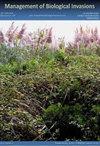What is the potential for extirpating spectacled caiman from Comprehensive Everglades Restoration Plan projects in South Florida?
IF 1.2
4区 环境科学与生态学
Q3 BIODIVERSITY CONSERVATION
引用次数: 1
Abstract
Spectacled caimans ( Caiman crocodilus Linnaeus, 1758) are established invaders in the United States, Cuba, and San Andres Island, Colombia. They have been established in South Florida since the 1970s and are found primarily within Comprehensive Everglades Restoration Plan (CERP) projects. These projects provide suitable habitat and may provide dispersal pathways via water management activities. Caiman presence in these areas directly conflicts with the CERP’s goals, and as a generalist species with a broad diet, they can impact biological resources. Past removal efforts failed to extirpate caimans, but their efficacy has not been well evaluated. We addressed caimans via removal surveys during 2012–2021 with the goal of evaluating extirpation or maximum species control within South Florida’s CERP projects. Documented opportunistic removals for this study began in December 2012, and systematic efforts have been ongoing since October 2017. We evaluated efficacy of caiman removals by analyzing 10 years of opportunistic and systematic survey data, plus associated removal data, along 11 survey routes during 2012–2021. We also conducted necropsies to collect biological information which could be used to improve removal efforts. We removed 251 caimans during 2012 to 2021, and the rate of caiman removals per year increased from 5 animals during 2012 to a peak of 47 animals during 2020. Necropsies revealed reproductive information (nesting/ hatching timelines) that we applied to improve our removal rates. Caiman encounter rates declined from a peak of 1.55 ± 0.66 caiman/hr and 0.72 ± 0.38 caiman/km during 2013 to a low of 0.18 ± 0.09 caiman/hr and 0.03 ± 0.02 caiman/km during 2020 and slightly increased during 2020–2021, likely because of a change in search effort. We evaluated and discussed the potential for extirpating caiman from CERP projects and provide a data-driven prescription for removal efforts.从南佛罗里达的综合沼泽地恢复计划项目中灭绝眼镜凯门鳄的潜力是什么?
眼镜凯门鳄(林奈凯门鳄,1758年)是美国、古巴和哥伦比亚圣安德烈斯岛的入侵者。自20世纪70年代以来,它们已经在南佛罗里达州建立起来,主要是在综合沼泽地恢复计划(CERP)项目中发现的。这些项目提供了合适的栖息地,并可能通过水管理活动提供扩散途径。凯门鳄在这些地区的存在直接与CERP的目标相冲突,作为一种饮食广泛的多面手物种,它们会影响生物资源。过去的清除努力未能消灭凯门鳄,但其效果尚未得到很好的评估。我们通过2012-2021年期间的搬迁调查来解决凯门鳄问题,目的是评估南佛罗里达州CERP项目中的灭绝或最大物种控制。本研究记录的机会性清除始于2012年12月,自2017年10月以来一直在进行系统的努力。通过分析2012-2021年期间11条调查路线上10年的机会性和系统性调查数据,以及相关的清除数据,我们评估了凯门鳄清除的效果。我们还进行了尸体解剖,以收集生物信息,这些信息可用于改善清除工作。我们在2012年至2021年期间清除了251只凯门鳄,凯门鳄的移除率从2012年的每年5只增加到2020年的47只。尸检显示了繁殖信息(筑巢/孵化时间),我们应用这些信息来提高移除率。凯门鳄遭遇率从2013年的峰值1.55±0.66凯门鳄/小时和0.72±0.38凯门鳄/公里下降到2020年的低点0.18±0.09凯门鳄/小时和0.03±0.02凯门鳄/公里,并在2020 - 2021年期间略有上升,可能是因为搜索努力的变化。我们评估和讨论了从CERP项目中消灭凯门鳄的潜力,并为清除工作提供了数据驱动的处方。
本文章由计算机程序翻译,如有差异,请以英文原文为准。
求助全文
约1分钟内获得全文
求助全文
来源期刊

Management of Biological Invasions
Agricultural and Biological Sciences-Ecology, Evolution, Behavior and Systematics
CiteScore
3.40
自引率
6.70%
发文量
21
审稿时长
16 weeks
期刊介绍:
Management of Biological Invasions, established in 2010 by Dr. Elias Dana, is an open access, peer-reviewed international journal focusing on applied research in biological invasions in aquatic and terrestrial ecosystems from around the world. This journal is devoted to bridging the gap between scientific research and the use of science in decision-making, regulation and management in the area of invasive species introduction and biodiversity conservation.
Managing biological invasions is a crisis science, with Management of Biological Invasions aiming to provide insights to the issues, to document new forms of detection, measurements and analysis, and to document tangible solutions to this problem.
In addition to original research on applied issues, Management of Biological Invasions publishes technical reports on new management technologies of invasive species and also the proceedings of relevant international meetings. As a platform to encourage informed discussion on matters of national and international importance, we publish viewpoint papers that highlight emerging issues, showcase initiatives, and present opinions of leading researchers.
 求助内容:
求助内容: 应助结果提醒方式:
应助结果提醒方式:


